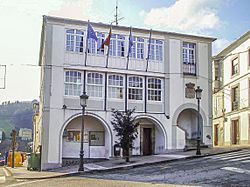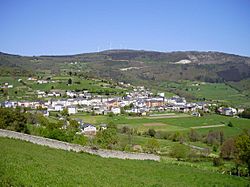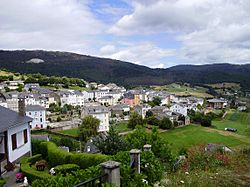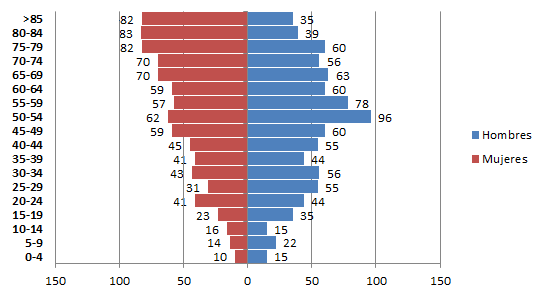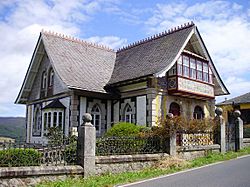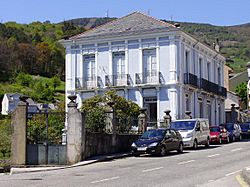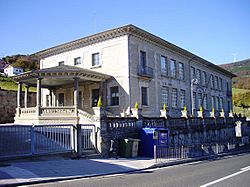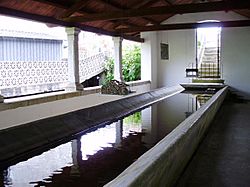Boal facts for kids
Quick facts for kids
Boal
Bual
|
||
|---|---|---|
|
||
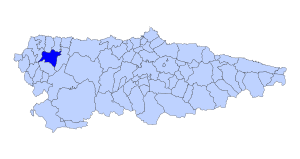 |
||
| Country | ||
| Autonomous community | ||
| Province | Asturias | |
| Comarca | Eo-Navia | |
| Judicial district | Valdés | |
| Capital | Boal | |
| Area | ||
| • Total | 120.28 km2 (46.44 sq mi) | |
| Highest elevation | 1,201 m (3,940 ft) | |
| Population
(2018)
|
||
| • Total | 1,571 | |
| • Density | 13.061/km2 (33.828/sq mi) | |
| Demonym(s) | boalés / boalesa | |
| Time zone | UTC+1 (CET) | |
| • Summer (DST) | UTC+2 (CEST) | |
| Postal code |
33720
|
|
Boal (in Galician-Asturian: Bual) is a town, a civil parish, and a municipality in the region of Asturias, Spain. It shares borders with El Franco and Coaña to the north, Illano to the south, Castropol to the west, and Villayón to the east.
The main way to reach Boal is by the AS-12 road. This road connects Navia with Grandas de Salime. The whole municipality has about 1,632 people living there. The main town of Boal has about 496 residents.
Contents
What Does "Boal" Mean?
The name "Boal" likely comes from old words. Some think it comes from an Indo-European word meaning "stream" or "ditch." Others believe it comes from a Latin word related to "ox."
Many people think "Boal" means "land often used by cattle for grazing." It could also mean "a corral for oxen" or "ox pasture." So, the name probably tells us about the area's history with cattle.
Boal's Past: A Journey Through Time
Ancient Times: Early Settlers
Long ago, even before the Romans arrived, people lived in the Boal area. We don't have proof from the Paleolithic Age, but we do have signs from the Neolithic Age. For example, many burial mounds were found in the Penouta mountains. This is one of the largest burial mound sites in all of Asturias, with 72 tombs!
Ancient dolmens (stone structures) near Llaviada also date back to this time. Paintings of people were found in the Cova del Demo (Cave of the Devil). These paintings are from the Bronze Age, around 1500-1100 BC.
Signs of old mining work and Celtic fortifications also show that people lived here before the Romans.
Roman and Barbarian Times
The Romans came after the Celts. They left behind coins and pottery. Some small villages, like Vega de Ouria, might even get their names from Roman gold mining.
After about 400 years, barbarians entered Spain. The Suebi and later the Visigoths settled in this area. But there are not many old remains from these groups.
Middle Ages: Bishops and Lords
In the early Middle Ages, the bishops of Oviedo and Lugo argued over land. In 1154, Boal and nearby areas became part of the bishop of Oviedo's land. This land was called Castropol.
Later, in 1368, a bishop gave control of a large area, including Boal, to Alvar Pérez Osorio. This was a tough time because Pérez Osorio made people pay very high taxes.
Over time, new villages and municipalities were created. By the 1500s, Boal was part of the municipality of El Franco.
Modern Ages: Becoming Independent
This changed when King Felipe II came to power. He got permission from the Pope to sell towns and their control. This helped him pay for wars.
People in villages often bought their freedom from lords. They didn't want to be controlled by them. So, in 1580, the parishes of Boal, Serandinas, and Doiras bought their independence. They then reported directly to the King.
Boal officially became its own municipality in 1584. Representatives from its villages met and created the first local rules. They decided how to choose their leaders. The capital of the municipality moved around for a while. But in 1791, it finally settled in the town of Boal.
In the 1600s and 1700s, farming and raising cattle were the main activities. Many beautiful family homes were built. The 1700s were a good time for Boal. Besides farming, crafts became important. There were mills for cloth, iron, and grain.
19th Century: Wars and Changes
During the Spanish War of Independence, French soldiers came to Boal in 1809. They thought there was a weapons factory there. They caused a lot of damage and deaths.
Later, in 1823, a group of robbers stole money and destroyed documents. In the Carlist Wars, a group of fighters entered Boal in 1836. Their leader was caught and executed.
The parish church, dedicated to Santiago Apóstol, opened in 1837. The town hall and jail opened in 1842.
Boal also faced health challenges. A cholera outbreak happened in 1854-1855, and a more serious smallpox outbreak in 1870.
A famous person from Boal, Bernardo Acevedo y Huelves, was born in the 19th century. He wrote a book called "Boal y su concejo" (Boal and its municipality). It described life in Boal at that time. It also showed how important iron working was.
In 1895, there was an uprising. Iron workers destroyed new machines. These machines were meant to make tacks faster. But the workers feared they would lose their jobs to new technology and foreign competition.
20th Century: Emigration and Development
The late 1800s and early 1900s saw many people leave Boal. They went to places like Argentina and Cuba in the Americas. These emigrants often sent money back home. This money helped build schools in Boal, like "Las Graduadas" in 1934. It also helped build public washing houses.
Important new structures were built in the 20th century. A road connecting Navia and Boal was finished. In 1934, the Doiras dam was built. From 1951 to 1961, tungsten mines near Penouta were very active.
When the mines closed and big dams were finished, many jobs were lost. Farming also changed. This led to more people leaving Boal, especially after the 1950s. They moved to other parts of Spain or to countries in Europe like Germany and France. This caused the population to shrink, and it continues to do so today.
Boal's Landscape: Geography
Physical Features
Boal is located in the middle part of the Navia River basin. The Navia River flows through the municipality. It forms a natural border with Villayón. The river is held back by dams in Boal, like the one in Doiras. Other rivers, like the Urubio River and the Pendia River, flow into the Navia River here.
The highest point in Boal is La Bobia mountain, which is 1,201 meters high. Other notable mountains include La Cristaleira (1,036 m) and Penouta (899 m). From Penouta, you can see a wide view of the coast. The main town of Boal is located about 450 meters above sea level. It sits near the Pendia River, surrounded by mountains.
Civil Parishes of Boal
The municipality of Boal is divided into 7 main areas called civil parishes:
- Boal (Bual): 966 people
- Castrillón (Castriyón): 182 people
- Doiras: 153 people
- Lebredo (Llebredo): 13 people
- La Ronda (A Ronda): 63 people
- Rozadas: 176 people
- Serandinas (Serandías): 223 people
(Source: INE)
Main Populated Places
Here are some of the biggest villages and towns in Boal:
- Boal: 526 people
- Armal: 154 people
- Doiras: 98 people
- Miñagón: 94 people
- Rozadas: 79 people
- Serandinas: 69 people
- Prelo: 61 people
- Los Mazos: 49 people
- Sampol: 41 people
- Castrillón: 39 people
(Source: INE)
The Parish of Boal
The parish of Boal covers about 25.93 km2 (10.01 sq mi). It has a population of 1,137 people (2007).
The town of Boal is the main center of this parish and the capital of the municipality. It is located on the side of the Penouta mountains, about 450 meters above sea level. The town has 588 residents and is divided into three main parts:
- Boal de Arriba (Upper Boal): This is the oldest part of the town. It has narrow streets and old houses. There's also a fairground for cattle markets and the cemetery here.
- Zona central (Central area): This area includes the Church Square, where the Santiago Apóstol church is. It also has the Town Hall Square and Asturias Avenue. Here you'll find the House of Culture, which has the municipal library, and most of the shops, bars, and hotels.
- Boal de Abajo (Lower Boal): This part has grown along the AS-12 road. You can see interesting buildings here, like Casa de Damiana (built in 1919) and Villa Anita (built in 1926). These were built by emigrants who became wealthy in the Americas. The elementary school, high school, sports center, and pool are also in this area.
Villages in Boal Parish
|
|
|
|
Population Changes in Boal

In the early 1900s, Boal's population slowly grew. It increased a lot when the Doiras dam was built in 1930. That year, Boal had its highest population ever: 7,365 people.
The population stayed high until about 1960. This was because of the dam, tungsten mining near Penouta, and traditional farming that needed many workers. Boal was once the most populated municipality in the middle Navia River area.
However, after 1960, the mines closed. Farming also changed. This led to many people leaving Boal. This movement of people is called Emigration.
At first, people moved overseas to the Americas, especially to Argentina and Cuba. These emigrants often sent money back to Boal. This money helped build schools and other buildings. But this flow of money stopped after the Cuban Revolution.
In the mid-1900s, people started leaving again. This time, they went to other parts of Spain (like Gijón and Avilés) or to European countries like Germany and France. This has caused Boal's population to get smaller.
Today, many people in Boal are older. About 42.7% of the population is over 60 years old. Only about 8.4% are under 20 years old.
Boal's Economy: How People Make a Living
Even though many people work in the service sector, farming is still very important in Boal. Almost one-third of the working people are involved in raising cattle. They mainly produce milk. Boal is the biggest milk producer among the western municipalities in Asturias.
In recent years, apiculture (beekeeping) has grown a lot. Honey is now one of Boal's most famous products. For many families, beekeeping is a way to earn extra money. There's even a special Honey Fair (Feria de la Miel) in Boal! A company called Boal Apícola sells about 20 tons of honey each year.
| Number of Workers | Percentage | ||||
|---|---|---|---|---|---|
| TOTAL | 458 | 100 | |||
| Agriculture, cattle farming and fishing | 134 | 29.26 | |||
| Industry | 16 | 3.49 | |||
| Construction | 30 | 6.55 | |||
| Service sector | 298 | 65.06 | |||
| *Data from the Anuario Estadístico de Asturias 2011, SADEI | |||||
| Uses | Area (km²) | ||||
|---|---|---|---|---|---|
| Farming land | 0.99 | ||||
| Meadows and pastures | 30.51 | ||||
| Forest | 55.90 | ||||
| Other uses (industrial, residential, etc...) | 32.88 | ||||
| *Data from the Anuario Estadístico de Asturias 2011, SADEI | |||||
Boal's Delicious Food: Gastronomy
Boal is a farming area, so you can find many fresh, natural foods. Its vegetables, beans, and potatoes are excellent. Traditional cooking in Boal uses these ingredients. A typical dish is soup with "cimois" (rapini) or collard greens.
Since there's a lot of meat like veal, pork, kid, and lamb and mutton, you'll find dishes like meat or sausages pie. Another popular dish is lacón (cured pork shoulder) with rapini and "cachelos" (cooked potato pieces). Corn "rapa" (a pie-like dish with corn and bacon) is also common.
Wild game is also part of Boal's cooking. You might find roe deer and wild boar, as well as birds like partridge and Eurasian woodcock.
For sweets and pastry, try "cocadas" (coconut sweets), "venera" (an almond-based treat), and "cereixolos". Honey is used in many local recipes, which makes sense since it's a famous product here. Of course, you can also enjoy other asturian typical dishes in Boal.
Exploring Boal: Tourism
Boal has many interesting places to visit. The oldest signs are the cave paintings in the Cova del Demo. These paintings show men, women, and animals. You can also see beautiful old buildings like palaces, large houses, and churches. Here are some highlights:
- The Miranda Palace in Prelo: This palace was built between the 1400s and 1500s. It was declared an important cultural site in 1982. It started as a square tower and was later expanded. The palace has a large family coat of arms above its entrance.
- The Berdín Palace in Doiras: Built in the 1700s, this palace is very large. It has plain walls made of stone. Its shape is like a "U," and it has a gallery with stone columns.
- The Palace of Armal: This palace looks like a typical large country house. It's built with stone and slate and has simple decorations.
- Villa Anita: An emigrant who made money in Cuba built this villa in 1926. It has three floors and shows English, Japanese, and medieval styles. The front is decorated with white ceramic tiles.
- Villa Damiana: Built in 1919, this is another beautiful example of old architecture.
- Old Elementary School "Escuelas Graduadas" in Boal: This school was built between 1930 and 1934. It was funded by emigrants from Boal who had moved to La Habana, Cuba. It's a large stone building with big windows. It had two separate entrances, one for boys and one for girls.
- The Church of Santiago Apóstol in Boal: This church was built from 1831 to 1837. It has a Latin cross shape and a side porch made of granite.
- The public Washing House in Boal: This building was opened in 1928, thanks to money sent by emigrants. It has been restored and is now a museum about washing houses in Boal. It shows how much the returning emigrants cared for their hometowns.
- Casa de la Apicultura: This is a museum about beekeeping.
Fun in Boal: Festivities
Boal has many fun festivals and fairs throughout the year:
- May 15: The feast of San Isidro. It's held near his small church in the mountains.
- June 13 and 14: The feast of San Antonio in Armal.
- July 24, 25 and 26: The feast of Santiago Apóstol in Boal. Also, on July 21 and 22, the feast of the Virgen de la Magdalena in Doiras.
- August 25: The feast of San Luis in the village of the same name.
- October/November: The Feria de la Miel (Honey Fair) is held on the last weekend of October or the first weekend of November.
Boal also has a market every two weeks on alternate Mondays. There are also several cattle markets during the year. Two are held in Boal on the second Saturday of October and the last Saturday of April. Two others are held in the La Bobia mountains: on May 29 (for San Fernando) and on June 26 (for San Pelayo).
Famous People from Boal
- Celestino Álvarez: A writer and journalist who moved to Cuba.
- Carlos Bousoño: A well-known poet and literary critic.
See also
 In Spanish: Boal para niños
In Spanish: Boal para niños




